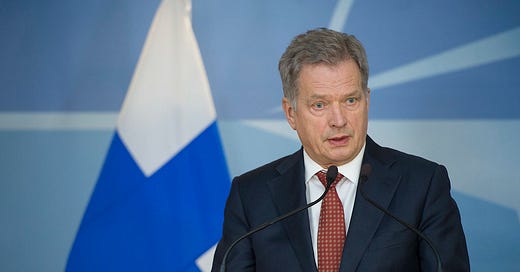
Finland has recently joined the group of personae non gratae in the market of Russian natural gas. Russia halted gas exports to Finland last week after Finnish President, Sauli Niinistö, announced their new desire to join NATO and refusal to pay for gas in rubles.1 Surprise, surprise. This entire war is about the expansion of NATO on Russia’s border, so of course, all we continue to see is an exacerbation of the war instead of any effort of diplomacy.
Finland might have it easier than the other European countries that have refused to pay in rubles. Apparently, only ~5% of total energy consumption in Finland comes from Russian natural gas. But ol’ George Soros—Dr. Evil incarnate—wants the real-life game of Risk to continue indefinitey. In a letter to Italy’s prime minister, Mario Draghi, Soros encourages the EU to maintain their position by telling them they may have an edge:
“Europe is [Putin’s] only market … If he doesn't supply Europe, he must shut down the wells in Siberia from where the gas comes. It takes time to shut them down and once they are shut down, they are difficult to reopen because of the age of equipment.”
But Soros cares not for the effect this will have on the people of Europe (or those of Ukraine or Russia for that matter). Soros also called on Europe to levy heavy taxes on gas imports, increasing the cost of living for struggling Europeans even further. All Soros cares about is the global order. He stated,
“Russia would never regain the sales it has lost.”
People like Soros will continue to intensify a tense situation. His goals, and those of the World Economic Forum, do not align with people who just want to live in peace and be able to afford basic goods and services.
The Ruble Takes a Hit
The strength of the Russian currency is related to the geopolitical war games. The currency hit a 7-year high against the US dollar just last week on May 23rd despite the ongoing war in Ukraine and continuation of Western sanctions.
At the end of April, the ruble had completely recovered from its dramatic drop in relative value due to the start of the sanctions. And it continued to strengthen. I believe that strong recovery was a direct result of a series of key decisions, namely the following:
The Central Bank of Russia significantly hiked its key interest rate up to 20% immediately after the invasion and resulting sanctions
At the end of March, Russia declared it would resume gold purchases at a fixed price of 5,000 rubles per gram
Russia demanded payment for natural gas in rubles for non-friendly customers in the EU
But then the Bank of Russia did an about-face and stopped its gold purchases at the fixed price and instead announced it will buy at a “negotiated price”—a loss of credibility in my book. Then it reversed the key interest rate by cutting it sharply twice, each time by 3%. So, last month I wrote that I expected to see the ruble lose its recent gains because of these actions.
The ruble’s relative strength continued to soar through the month of May. That is, until earlier this week when the rally stopped abruptly and the ruble erased more than half of its May-gains.

On Thursday, May 26th, the Bank of Russia cut its key interest rate a third time by another 3%!2 The central bank seems to fear a strong currency. This conflicts with the goals of the Kremlin, which purportedly wants a sovereign ruble pegged to gold. It is unclear why the Bank of Russia is working against itself. Perhaps the government is reverting back to depreciating their currency to continue help financing their war in Ukraine. Just when the Russian people start to see the potential for an increase in their standard of living, the government knocks them right back down.
These recent devaluation moves also seem to give the EU an advantage as European countries hold off on yielding to Russia’s gas payment demands. What is going on in the minds of Russian central bankers?
It would be nice to see the war come to an end very soon. Unfortunately, diplomacy still remains to be seen. The ruble will continue to lose its gains as long as the Bank of Russia continues to reverse course. And the people of Ukraine and Russia will continue to suffer as the war endures.




